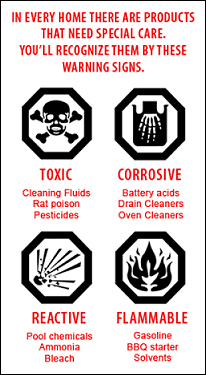|
Spring Cleaning
Greening Spring Cleaning
Schools should stop dousing classrooms
with toxic cleaning products.
By Allison Rich
W hat's that smell in the air? It's fresh and floral — and probably filled with formaldehyde.
It's spring-cleaning time once again. And in the name of cleanliness, people everywhere are dousing their homes and workplaces with dangerous, even toxic, cleaning products.
 Have you ever looked at the list of ingredients on the back of the cleaning bottle? Notice the warnings, often in all caps. CAUTION: KEEP AWAY FROM CHILDREN! Or, DANGER: Avoid contact with skin, eyes, mucous membranes, and clothing. Have you ever looked at the list of ingredients on the back of the cleaning bottle? Notice the warnings, often in all caps. CAUTION: KEEP AWAY FROM CHILDREN! Or, DANGER: Avoid contact with skin, eyes, mucous membranes, and clothing.
Most traditional cleaning products can contribute to serious health problems — from asthma to cancer to reproductive disorders.
The Environmental Working group evaluated 2,000 common cleaning products and found that over half contain ingredients known to harm the lungs alone. And nearly a quarter contain chemicals known to cause asthma in otherwise healthy individuals.
O ne chemical, triclosan — which is found in 75 percent of liquid hand soaps in the United States — contributes to skin irritation, endocrine disruption, and compounded antibiotic resistance. And it all ends up accumulating in our water systems, where it can affect people who don't even use the soap.
Children are especially at risk.
Yet schools and child care facilities, where messes are common and germs run amok, rely heavily on these chemical concoctions.
It's truly daunting to think how many dangerous chemicals are unregulated and under-researched but over-used where children learn and play. And the health impacts are detrimental to the learning environment.
Students in America miss approximately 14 million school days per year because of asthma alone, the Centers for Disease Control found. Studies suggest that curbing exposure to indoor environmental factors could prevent more than 65 percent of asthma cases among elementary school-age children.
Unfortunately, America's main chemical safety law — the Toxic Substances Control Act — makes it very difficult to ban dangerous chemicals, even those that are known to cause serious health effects.
That makes state action imperative. In 2012, my state of Maryland became one of just 11 to pass a law mandating green cleaning in schools.
That means using certified products that don't contain ingredients linked to asthma and cancer, including phthalates and heavy metals. Green cleaning saves money, reduces illness-related absenteeism, and contributes to better indoor air quality — so staff and students alike can breathe easier.
More than 60 million people — including students, teachers, and staff — spend about half their days inside school buildings. That's nearly one in five Americans.
W hy should they be exposed to unsafe cleaning products when there's a better alternative?
This spring-cleaning season, ask your local school board to phase out chemicals that pollute the environment and contribute to long-term health problems in kids. Schools that want to stop using dangerous chemicals can find help from plenty of science-based resources.
The Healthy Schools Network's Cleaning for Healthy Schools website offers some great solutions for phasing out dangerous chemicals. So does the EPA's Tools for Schools program, the Children's Environmental Health Network's Eco-Healthy Child Care Program, and the Responsible Purchasing Network.
Meanwhile, local communities should demand that their state governments tighten restrictions on dangerous chemicals.
We can do this. Keeping schools clean shouldn't make our kids sick. (First published 22 April 2015)
Allison Rich is the Communications Manager and Children's Environmental Health Specialist at the Maryland Environmental Health Network. Distributed by OtherWords.org
|
|
|

